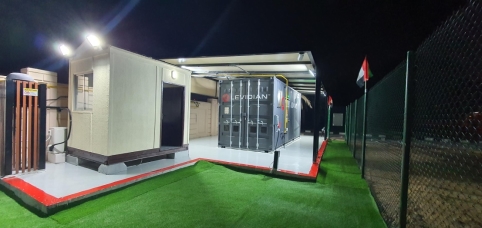Khalifa University partners with Zero Carbon Ventures for research into groundbreaking decarbonization technology

The Research and Innovation Center for Graphene and 2D Materials (RIC-2D) based in Khalifa University of Science and Technology, an internationally top-ranked research-intensive university located in Abu Dhabi, UAE and Zero Carbon Ventures, a company dedicated to bringing carbon-reducing technologies to the Middle East, have joined forces to develop local applications for carbon reduction LOOP technology developed by UK climate tech company, Levidian Nanosystems.
The RIC-2D at Khalifa University and Zero Carbon Ventures have erected a site for the carbon-reducing technology at the Arzanah Complex at the university’s Sas Al Nakhl (SAN) Campus, in Abu Dhabi. Research will be conducted on the system’s input and outputs, to develop its applications for different waste gas blends, such as those in the oil and gas industry, agriculture, landfill, and wastewater treatment plants.
Levidian’s LOOP technology demonstrates the ability to process captured methane as a key tool in the journey to a decarbonised world. Methane is cracked to produce Hydrogen, a fuel of the future, and Graphene which has the potential to impact a broad range of industries.
Earlier this year, Zero Carbon Ventures partnered with Levidian to deploy their innovative LOOP technology in the UAE.
The partners will work together on a project-by-project basis – initially on the LOOP technology, but with a vision to collaborate on other programs in the future.
Dr. Hassan Arafat, Senior Director, RIC-2D said: “RIC-2D is pleased to partner with Zero Carbon to jointly work on local applications for carbon reduction LOOP technology developed by Levidian Nanosystems. The cutting-edge Graphene and Hydrogen production technology installed at Khalifa University’s SAN Campus demonstrates our emphasis on bringing world-class innovative Graphene technologies to the UAE and the region. RIC-2D researchers will focus on developing applications for different waste gas blends, such as those in the oil and gas industry, agriculture, landfill, and wastewater treatment plants.”
Martin Reynolds, CEO of Zero Carbon Ventures “Methane is one of the worst greenhouse gasses when liberated to the atmosphere. This technology from Levidian is a great example of the kinds of technology we aim to support the development of in the region. We have big plans to deploy it across industry in the UAE, initially, with a particular focus on decarbonizing waste methane from landfill sites. Our partnership with Khalifa University; one of the world’s best science and technology research centres, provides us with fantastic validation and support of the goals we have set ourselves. We are looking forward to seeing the results of this amazing work that will inevitably lead to advancements in the country’s mission to achieve Net Zero.”
The RIC-2D hosted by Khalifa University of Science and Technology is part of a strategic investment by the Government of Abu Dhabi, in the UAE, to advance the scientific development and commercial deployment of technologies derived from graphene and other 2D materials. RIC-2D serves as an integral part of an advanced materials innovation ecosystem being developed in Abu Dhabi.






